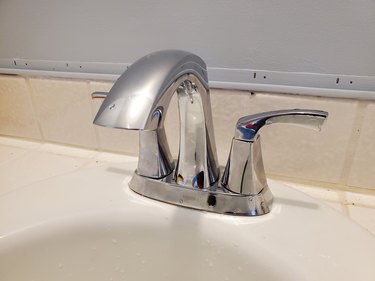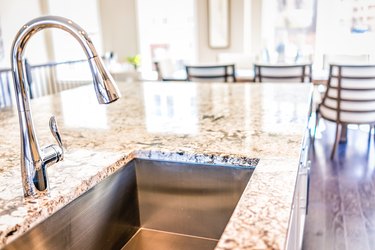

For something you almost never think about, your plumbing system sure does have a big impact on your quality of life. You count on it to work effectively and quietly. So, when air gets into your water pipes and starts creating rattling, hissing, or popping noise in the pipes, it's not something you'll want to endure for long.
Air bubbles can enter your water pipes after you make repairs to your plumbing system or after your local water authority makes repairs to the central plumbing system to which your home's pipes connect. Luckily, getting rid of trapped air in the pipes has an easy fix, and you'll know right away if it worked.
Video of the Day
Video of the Day
Tip
In homes that use well water, air bubbles can get into the pipes when there's a leak or malfunction somewhere in the system. Because air in the lines of a well water system can mean something needs to be fixed or replaced, call in a plumber to investigate right away.
How to Get Rid of Air in Water Pipes
Step 1: Close the Main Shutoff Valve
Since air bubbles are trapped inside the water that's moving around your pipes, your goal is to force all that water and air out through your faucets. To empty the pipes, you need to prevent more water from flowing in. This means turning off the water supply to your home by closing the main water shutoff valve. If you're not sure where it is, you'll often find the main shutoff valve in the basement somewhere along the perimeter of the foundation. Sometimes, a home's shutoff valve will be located in a crawl space, near the water heater, under the kitchen sink, or on the outside of the home's foundation.
Unlike the valves that control water supply to individual fixtures, like sinks and toilets, the main shutoff valve is generally painted red and is most commonly shaped like a lever or like a round knob. Shut a lever valve by turning the lever 90 degrees so it's perpendicular to the water pipe or turn a round valve clockwise to close it.
A valve that hasn't been opened in a long time may not budge when you first try to turn it. Do not force a stuck valve or it may break. Try spraying the valve with penetrating oil, which is designed to loosen stuck nuts and bolts, and wait a few minutes before trying to turn the valve again. If it doesn't move, spray it again and clamp a pipe wrench around the valve. Then, use a rubber mallet or hammer to gently tap the handle of the wrench. Heating the valve with a hair dryer may also budge it, but if nothing works, call in a plumber rather than risking breaking the valve.
Step 2: Empty the Water Pipes
Once the water is off, walk around your home to every fixture that connects to the main water supply. The goal is to open every "door" that water uses to get from your pipes into your home so all of that trapped air is forced out into your fixtures.
Open every faucet in the home about halfway and let them run. Flush every toilet. Run the dishwasher and washer empty to pull in the water that's already in the pipes connected to these machines. If your fridge has a built-in water dispenser, empty the water into pitchers until the dispenser runs dry. Outdoors, open any spigots connected to the house.
Step 3: Open the Main Shutoff Valve
After flushing the toilets, starting the dishwasher and washing machine, and opening every faucet, turn the water back on by reopening the main shutoff valve. Let the faucets and machines continue to run and flush the toilets again to refill them. Once the water has been on for about 10 minutes, walk all around the home one more time to see if you can detect any more noises or if the water pipes sound quiet again. Finally, close all the faucets and turn off the dishwasher and washing machine.
Step 4: Address Remaining Sounds
Most people will need to call in a plumber to diagnose the problem if forcing air out didn't quiet the pipes. Trapped air is just one of the causes for strange sounds in your water pipes, and they don't all have easy DIY fixes.
For example, if you hear banging or knocking in the pipes, a phenomenon called water hammer may be responsible. It happens when water under high pressure is suddenly forced to stop moving. You'll often hear the sound of water hammer right after closing a faucet or whenever your washing machine finishes filling. Having a plumber cut into the pipe to install a water hammer arrestor, which functions like a shock absorber, should solve the problem.